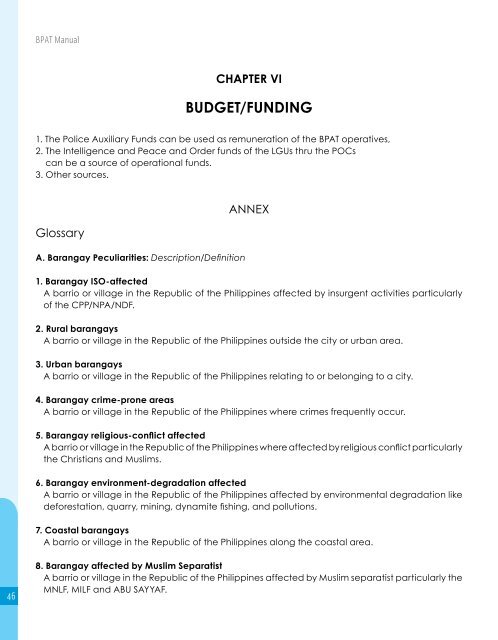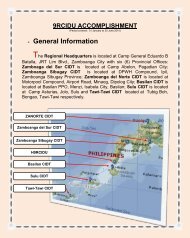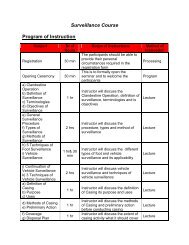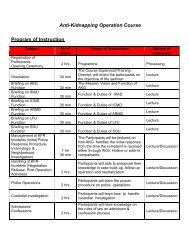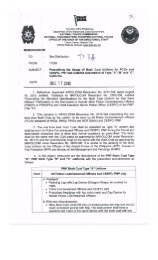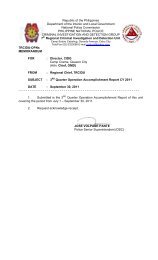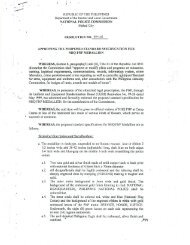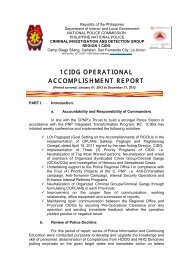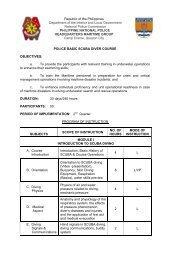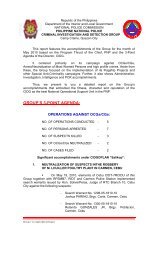Barangay Peacekeeping Operation - Philippine National Police
Barangay Peacekeeping Operation - Philippine National Police
Barangay Peacekeeping Operation - Philippine National Police
You also want an ePaper? Increase the reach of your titles
YUMPU automatically turns print PDFs into web optimized ePapers that Google loves.
BPAT Manual<br />
Budget/Funding<br />
CHAPTER VI<br />
B. Key Establishments/Areas: Description and effect/ influence on BPAT operational procedures<br />
BUDGET/FUNDING<br />
1. The <strong>Police</strong> Auxiliary Funds can be used as remuneration of the BPAT operatives,<br />
2. The Intelligence and Peace and Order funds of the LGUs thru the POCs<br />
can be a source of operational funds.<br />
3. Other sources.<br />
Glossary<br />
A. <strong>Barangay</strong> Peculiarities: Description/Definition<br />
ANNEX<br />
1. <strong>Barangay</strong> ISO-affected<br />
A barrio or village in the Republic of the <strong>Philippine</strong>s affected by insurgent activities particularly<br />
of the CPP/NPA/NDF.<br />
2. Rural barangays<br />
A barrio or village in the Republic of the <strong>Philippine</strong>s outside the city or urban area.<br />
3. Urban barangays<br />
A barrio or village in the Republic of the <strong>Philippine</strong>s relating to or belonging to a city.<br />
4. <strong>Barangay</strong> crime-prone areas<br />
A barrio or village in the Republic of the <strong>Philippine</strong>s where crimes frequently occur.<br />
5. <strong>Barangay</strong> religious-conflict affected<br />
A barrio or village in the Republic of the <strong>Philippine</strong>s where affected by religious conflict particularly<br />
the Christians and Muslims.<br />
6. <strong>Barangay</strong> environment-degradation affected<br />
A barrio or village in the Republic of the <strong>Philippine</strong>s affected by environmental degradation like<br />
deforestation, quarry, mining, dynamite fishing, and pollutions.<br />
7. Coastal barangays<br />
A barrio or village in the Republic of the <strong>Philippine</strong>s along the coastal area.<br />
1. Banks/Lending/Financial Establishments<br />
Organizations, usually corporations, which do most or all of the following: receives demand<br />
deposits and time deposits, honors instruments drawn on them, and pay interest on them;<br />
discounts notes, makes loans, and invests in securities; collects check, drafts , and notes; certifies<br />
depositor’s checks; and issues drafts and cashier’s checks.<br />
2. Parks<br />
Are protected areas, in its natural or semi-natural state or planted, and set aside for human<br />
recreation and enjoyment. It may consist of, rock, soil, water, flora and fauna and grass areas.<br />
3. Shrines<br />
Are holy or sacred places, which are dedicated to a specific deities, ancestors, heroes, martyrs,<br />
saints or similar figures of awe and respect, at which they are venerated or worshipped. Shrines<br />
often contain idols, relics, or other such objects associated with the figure being venerated.<br />
4. Resorts<br />
Are places used for relaxation or recreation, attracting visitors for holidays or vacations. Resorts<br />
are places, towns or sometimes commercial establishment operated by a single company. Such<br />
a self-contained resort attempts to provide for most of a vacationer’s wants while remaining on<br />
the premises, such as food, drink, lodging, sports, entertainment, and shopping.<br />
5. Beaches<br />
Are geological landforms along the shoreline of a body of water. It usually consists of loose<br />
particles which are often composed of rock, such as sand, gravel, shingle, pebbles, or cobble.<br />
The particles of which the beach is composed can sometimes instead have biological origins,<br />
such as shell fragments or coralline algae fragments.<br />
Beaches often occur along coastal areas, where wave or current action deposits and reworks<br />
sediments.<br />
6. Carnivals<br />
Are festive seasons which occurs immediately before Lent; the main events are usually during<br />
January and February. Carnival typically involves a public celebration or parade combining<br />
some elements of a circus, masque and public street party. People often dress up or masquerade<br />
during the celebrations, which mark an overturning of daily life.<br />
7. Tourist spots<br />
Locations that tourists typically go to when in that area.<br />
8. Schools/Colleges/Universities<br />
8. <strong>Barangay</strong> affected by Muslim Separatist<br />
Are institutions designed to allow and encourage students (or “pupils”) to learn, under the<br />
A barrio or village in the Republic of the <strong>Philippine</strong>s affected by Muslim separatist particularly the<br />
supervision of teachers. Most countries have systems of formal education, which is commonly<br />
46<br />
MNLF, MILF and ABU SAYYAF.<br />
compulsory. In these systems, students progress through a series of schools. The names for these<br />
schools vary by country (discussed in the Regional section below), but generally include primary<br />
47


